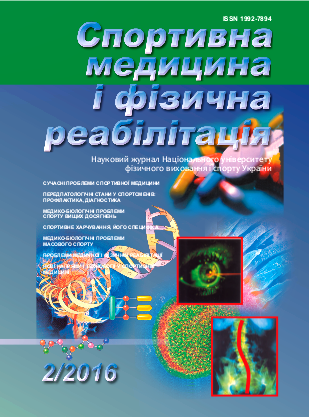Reactivity of cardiorespiratory system and manifestations of fast kinetics responses in athletes of different sports specialization
Основний зміст сторінки статті
Анотація
Блок інформації про статтю

Ця робота ліцензується відповідно до Creative Commons Attribution 4.0 International License.
Журнал практикує політику негайного відкритого доступу до опублікованого змісту, підтримуючи принципи вільного поширення наукової інформації та глобального обміну знаннями задля загального суспільного прогресу.
Редакційна колегія дотримується рекомендацій The Committee on Publication Ethics (COPE) з питань этики наукових публікацій.
ОБОВ'ЯЗКОВЕ ПОСИЛАННЯ НА АВТОРІВ ПРИ КОПІЮВАННІ ЧИ ЦИТУВАННІ МАТЕРІАЛУ НАУКОВИХ СТАТЕЙ
Автори, які публікуються у цьому журналі, погоджуються з наступними умовами:
- Автори залишають за собою право на авторство своєї роботи та передають журналу право першої публікації цієї роботи на умовах ліцензії Creative Commons Attribution License, котра дозволяє іншим особам вільно розповсюджувати опубліковану роботу з обов'язковим посиланням на авторів оригінальної роботи та першу публікацію роботи у цьому журналі.
- Автори мають право укладати самостійні додаткові угоди щодо неексклюзивного розповсюдження роботи у тому вигляді, в якому вона була опублікована цим журналом (наприклад, розміщувати роботу в електронному сховищі установи або публікувати у складі монографії), за умови збереження посилання на першу публікацію роботи у цьому журналі.
- Політика журналу дозволяє і заохочує розміщення авторами в мережі Інтернет (наприклад, у сховищах установ або на особистих веб-сайтах) рукопису роботи, як до подання цього рукопису до редакції, так і під час його редакційного опрацювання, оскільки це сприяє виникненню продуктивної наукової дискусії та позитивно позначається на оперативності та динаміці цитування опублікованої роботи (див. The Effect of Open Access).
Посилання
Buitrago S., Wirtz N., Yue Z. et al. (2012) Effects of load and training modes on physiological and metabolic responses in resistance exercise. European J. of Appl. Phys., vol. 112, no 7, pp. 2739–2748.
Burnley M., Jones A. (2007) Oxygen uptake kinetics as a determinant of sports performance. Eur. J. Sport Sci., vol. 7 (2), pp. 63–79.
Caputo F., Denadai B. (2004) Effect of aerobic endurance training status and specificity on oxygen uptake kinetics during maximal exercise. Eur. J. Appl. Phys., vol. 93, no 1–2, pp. 87–95.
Edgett B. A., Ross J. E. D., Green A. E. et al. (2013) The effects of recreational sport on VO 2peak , VO 2 kinetics and submaximal exercise performance in males and females. Euro pean J. of Appl. Phys., vol. 113, no 1, pp. 259–266.
Fiamma M. N., Straus C., Thibault S. et al. (2007) Effects of hypercapnia and hypocapnia on ventilatory variability and the chaotic dynamics of ventilatory flow in humans. Am. J. Physiol. Regul. Integr. Comp. Physiol, vol. 292, p. 1985.
Grassi B., Porcelli S., Salvadego D., Zoladz J. A. (2011) Slow VO 2 kinetics during moderate-intensity exercise as markers of lower metabolic stability and lower exercise tolerance. European J. of Appl. Phys., vol. 111, no 3, pp. 345– 355.
Harvey J. A. (2011) A Review: Analyzing How Oxygen Uptake Kinetics Limit Exercise Performance. J. of Exercise Phys. online, vol. 14 (3), pp. 67–73. 8. Inbar O., Faina M., Demarie S., Whipp B. J. (2013) VO 2 Kinetics during Moderate Effort in Muscles of Different Masses and Training Level. SRN Physiology (electronic journal), vol. 2013, article ID 101565, 9 pages. Available at: https:// www.hindawi.com/journals/isrn/2013/101565/ (accessed 15 May 2016).
Kovalenko S. O., Hrechukha S. V., Kudiy L. I. (2012) Probe analysis of lungs maximum ventilation with additional respiration rsistance. Medical Informatics and Engine ering, no 4, DOI: http://dx.doi.org/10.11603/mie.1996-1960 2012.4.408, Available at: http://ojs.tdmu.edu.ua/index.php/ here/article/view/408 (accessed 22 May 2013)
Mishchenko V. S., Lysenko E. N., Vinogradov V. E. (2007) Reaktivnye svojstva kardiorespiratornoj sistemy kak otrazhenie adaptacii k napriazhennoj fizicheskoj trenirovke v sporte [Reactive properties of the cardiorespiratory system as a reflection of adaptation to strenuous physical training in sport]. Kyev: Scientific world. (in Russian)
Mishchenko V., Suchanowski A., Lysenko O. (2009) Changes Related to Fatigue in Cardiorespiratory Response Sensitivity to Hypoxic and Hypercapnic Stimulation during Strenuous Physical Load. Baltic J. of Health and Physi cal Activity (Formerly Research Yearbook), vol. 1, no 1, pp. 25–29.
Mishchenko V., Shynkaruk O., Suchanowski A., Lysenko O. (2010) Individualities of Cardiorespiratory Responsiveness to Shifts in Respiratory Homeostasis and Physical Exercise in Homogeneous Groups of High Performance athletes. Baltic J. of Health and Physical Activity, vol. 2, no 1, pp. 13–29.
Miyamoto T., Inagaki M., Takaki H. et al. (2012) Adaptation of the respiratory controller contributes to the attenuation of exercise hyperpnea in endurance-trained athletes. European J. of Appl. Phys., vol. 112, issue 1, pp. 237–251.
Phillips S. M., Green H. J., MacDonald M. J., Hughson R. L. (1995) Progressive effect of endurance training on VO 2 kinetics at the onset of submaximal exercise. J. of Appl. Phys., vol. 79, no 6, pp. 1914–1920.
Reis J. F., Alves F. B., Bruno P. M., Vleck V. (2012) Effects of aerobic fitness on oxygen uptake kinetics in heavy intensity swimming. European J. of Appl. Phys., vol. 112, no 5, pp. 1689–1697.
Tomiak T., Mishchenko V., Lusenko E., Diachenko A., Korol A. (2014) Effect of moderate and high intensity training sessions on cardiopulmonary chemosensitivity and time-based characteristics of response in high performance rowers. Baltic J. of Health and Physical Activity, vol. 6, no 3, pp. 218–228.
Zasada M., Mishchenko W., Sawczyn S., Lysenko O., Vinogradov W., Tomiak T. (2011) Cardiorespiratory responsiveness throughout continuous strenuous physical exercise and its individualities in endurance athletes. Medical and Bio logical Sciences, vol. 25, no 4, pp. 55–64.
